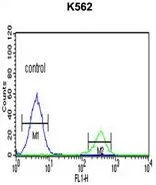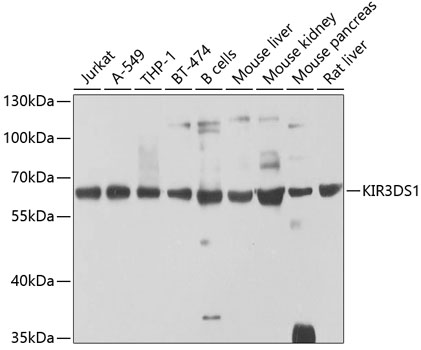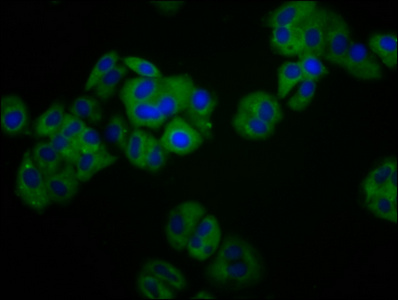
WB analysis of K562 cell lysate (35ug/lane) using GTX81103 KIR3DS1 antibody, C-term.
KIR3DS1 antibody, C-term
GTX81103
ApplicationsFlow Cytometry, Western Blot
Product group Antibodies
TargetKIR3DS1
Overview
- SupplierGeneTex
- Product NameKIR3DS1 antibody, C-term
- Delivery Days Customer9
- Application Supplier NoteWB: 1:1000. FACS: 1:10-1:50. *Optimal dilutions/concentrations should be determined by the researcher.Not tested in other applications.
- ApplicationsFlow Cytometry, Western Blot
- CertificationResearch Use Only
- ClonalityPolyclonal
- ConjugateUnconjugated
- Gene ID3813
- Target nameKIR3DS1
- Target descriptionkiller cell immunoglobulin like receptor, three Ig domains and short cytoplasmic tail 1
- Target synonymsCD158E2; killer cell immunoglobulin-like receptor 3DS1; killer cell immunoglobulin-like receptor KIR3DS1; killer cell immunoglobulin-like receptor, three domains, short cytoplasmic tail, 1; KIR-123FM; KIR-G1; natural killer-associated transcript 10; NKAT10; NKAT-10
- HostRabbit
- IsotypeIgG
- Protein IDQ14943
- Protein NameKiller cell immunoglobulin-like receptor 3DS1
- Scientific DescriptionKiller cell immunoglobulin-like receptors (KIRs) are transmembrane glycoproteins expressed by natural killer cells and subsets of T cells. The KIR genes are polymorphic and highly homologous and they are found in a cluster on chromosome 19q13.4 within the 1 Mb leukocyte receptor complex (LRC). The gene content of the KIR gene cluster varies among haplotypes, although several framework genes are found in all haplotypes (KIR3DL3, KIR3DP1, KIR3DL4, KIR3DL2). The KIR proteins are classified by the number of extracellular immunoglobulin domains (2D or 3D) and by whether they have a long (L) or short (S) cytoplasmic domain. KIR proteins with the long cytoplasmic domain transduce inhibitory signals upon ligand binding via an immune tyrosine-based inhibitory motif (ITIM), while KIR proteins with the short cytoplasmic domain lack the ITIM motif and instead associate with the TYRO protein tyrosine kinase binding protein to transduce activating signals. The ligands for several KIR proteins are subsets of HLA class I molecules; thus, KIR proteins are thought to play an important role in regulation of the immune response. Alternatively spliced transcript variants encoding different isoforms have been found for this gene. [provided by RefSeq, Aug 2013]
- Storage Instruction-20°C or -80°C,2°C to 8°C
- UNSPSC12352203





